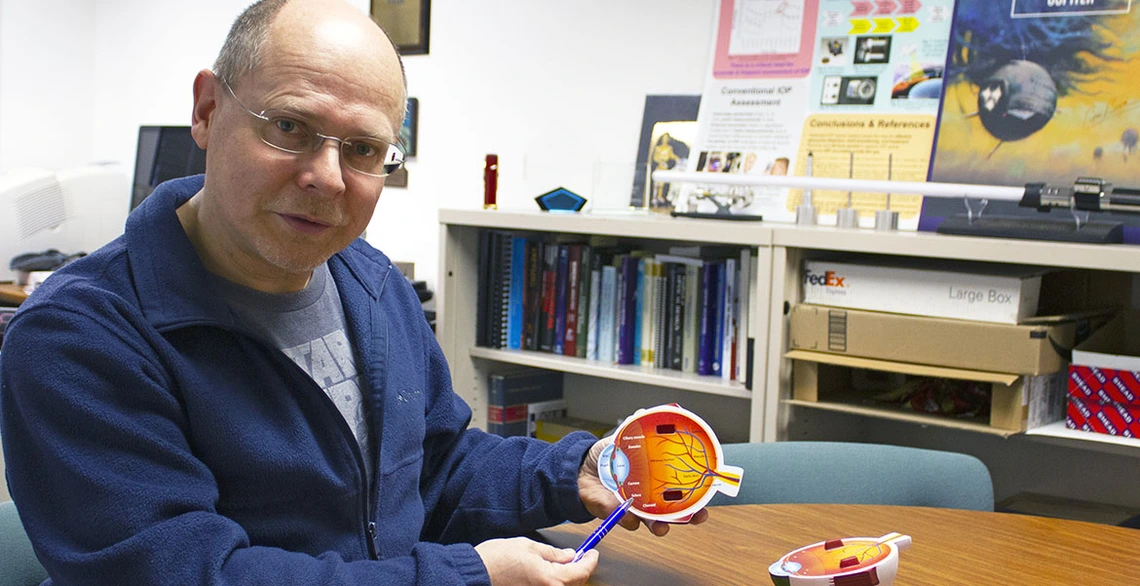International Achievement Award Highlights Decades of Optical Mastery
Wolfgang Fink holds commonalities with the award’s namesakes, who were leaders in establishing the UA as an optics powerhouse.

Associate professor Wolfgang Fink, 2023 recipient of the SPIE Aden and Marjorie Meinel Technology Achievement Award
Wolfgang Fink’s selection as this year’s recipient of the SPIE Aden and Marjorie Meinel Technology Achievement Award continues a distinguished legacy of optics and photonics at the University of Arizona. He received the award for his pioneering work on ophthalmic technologies, including visual prostheses and diagnostic methods.
SPIE, or the International Society for Optics and Photonics, has recognized some of the top minds in optics and photonics technology with this award since 1979, according to Jennifer Barton, president-elect of SPIE and director of the UA’s BIO5 Institute. Awardees include individuals, such as Tatsuo Harada at Hitachi, Ltd., who advanced optical grating technology, and married team Jean and Harold Bennett, who invented new precision optomechanics at the U.S. Naval Ordnance Test Station. Companies and federal research centers, such as Honeywell Corporation and NASA's Jet Propulsion Laboratory, California Institute of Technology, or JPL, have also received the award.
Fink is an associate professor of electrical and computer engineering who holds the inaugural Edward & Maria Keonjian Endowed Chair in Microelectronics and additional associate professorships in aerospace and mechanical engineering, biomedical engineering, ophthalmology and vision science, and systems and industrial engineering.
David W. Hahn, the Craig M. Berge Dean of the College of Engineering, said the award is well-deserved.
“I’m glad to see Wolfgang recognized for his impressive career. He continually expands ideas of what is possible through optical engineering, which has applications for medicine, space exploration and other disciplines. I’m eager to see what he will do next,” said Hahn.
Fink helped bring several vision-related devices and diagnostic technologies to market. His 20 U.S. and six foreign patents to date reflect innovations in tele-ophthalmology and ocular healthcare, including worldwide accessible visual performance tests, smartphone-based ophthalmic examination devices, a wireless implantable intraocular pressure sensor system to assist glaucoma therapy, and performance improvements for visual prostheses that advance the visual experience for the blind. Fink is the author of over 260 publications and holder of six fellowships.
Fink said he is grateful to receive an honor that celebrates the legacy of Aden and Marjorie Meinel and that places him in an esteemed class of awardees.
“I am deeply honored and humbled to be recognized alongside giants in astronomy, optics and optical sciences,” he said. “My profound gratitude goes to the SPIE and my peers worldwide for acknowledging my contributions to transformational opto-medical examination and device technologies in ophthalmology and tele-ophthalmology over the last 30 years.”
Shouleh Nikzad, a fellow, senior research scientist, principal engineer, and science division manager at JPL, said Fink is a fitting awardee.
“Dr. Fink applies his theoretical physics training and engineering knowledge to complex biological and physiological challenges that have great humanitarian impact, such as treatment and management of widespread ophthalmological diseases,” she said.
From 1964 to Now
The UA is internationally renowned for optics and photonics. The College of Engineering and the Wyant College partner to fulfill a national need for engineers and physicists in the optical sciences, educating more optics students than any other U.S. institution.
Many would point to 1964, when Aden Meinel founded the UA Optical Sciences Center, now the Wyant College of Optical Sciences, as a defining moment in the UA’s storied optics history. Fink’s professional journey contains significant overlaps with that of both the Meinels.
As the founder and director of the Visual and Autonomous Exploration Systems Research Laboratory, Fink is building on work he began at JPL 20 years ago. Conversely, Aden Meinel served as a UA professor for many years before he and Marjorie Meinel both went to work for JPL. SPIE selected both Fink and Aden Meinel as fellows.
Extending the Field
Fink’s expertise extends beyond helping those with vision problems to autonomous robotic space exploration, cognitive and reasoning systems, and computer-optimized design. Fink’s varied skill set is something he holds in common with Aden Meinel, said Barton.
“Wolfgang Fink and Aden Meinel share a love of forging new paths and having broad interests,” Barton said. “The University of Arizona is the perfect place for interdisciplinary work that draws upon and extends the field of optics.”
Aden came to the UA in 1961 as an astronomy professor and the director of the Steward Observatory. Marjorie, also an astronomer, raised the couple’s seven children and worked as Aden’s editor and co-author. When Marjorie died in 2008, the couple had been married 64 years. Aden died in 2011.
Since joining the UA faculty in 2009, Fink has been recognized nationally and internationally for his wide-ranging contributions. He was selected as the College of Engineering’s da Vinci Fellow for 2015, for example, for “innovative, productive and highly recognized engineering research.”
“Contributions across diverse disciplines are a direct result of the highly trans-disciplinary nature of my research,” said Fink.
This latest international acknowledgement of Fink’s work, made in the name of UA pioneers in the discipline, has the potential to expand the university’s optical engineering reputation, according to Barton.
“We are perhaps best known for our large mirrors and space sciences projects, but this award highlights our newer but considerable strengths in biophotonics and biomedical engineering,” she said.



